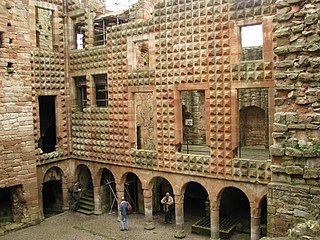Related Research Articles

Tam Lin, also known as Tamas-Lin, Tamlane, Tamlene, Tamlin, Tambling, Tomlin, Tam-Lien, Tam-a-Line, Tam-Lyn or Tam-Lane, is a character in the legendary ballad originating from the Scottish Borders.

Wemyss Castle is situated in Wemyss on the sea cliffs between the villages of East Wemyss and West Wemyss in Fife, Scotland. Wemyss Castle is considered to be a multi-period building, and today's castle includes many elements from former periods such as the 15th-century tower and the 19th-century stables and gatepiers.

"The Two Sisters" is a traditional murder ballad, dating at least as far back as the mid 17th century. The song recounts the tale of a girl drowned by her jealous sister. At least 21 English variants exist under several names, including "Minnorie" or "Binnorie", "The Cruel Sister", "The Wind and Rain", "Dreadful Wind and Rain", "The Bonny Swans" and the "Bonnie Bows of London". The ballad was collected by renowned folklorist Francis J. Child as Child Ballad 10 and is also listed in the Roud Folk Song Index. Whilst the song is thought to originate somewhere around England or Scotland, extremely similar songs have been found throughout Europe, particularly in Scandinavia.
"Geordie" is an English language folk song concerning the trial of the eponymous hero whose lover pleads for his life. It is listed as Child ballad 209 and Number 90 in the Roud Folk Song Index. The ballad was traditionally sung across the English speaking world, particularly in England, Scotland and North America, and was performed with many different melodies and lyrics. In recent times, popular versions have been performed and recorded by numerous artists and groups in different languages, mostly inspired by Joan Baez's 1962 recording based on a traditional version from Somerset, England.
"Hind Etin" is a folk ballad existing in several variants.
Fair Annie is a traditional folk ballad, existing in several variants.
Child Waters is an English-language folk song, existing in several variants.
"The Fair Flower of Northumberland" is a folk ballad.
"Gil Brenton" is an English-language folk song, existing in several variants.
"Earl Brand" is a pseudo-historical English ballad.

Francis Stewart, 5th Earl of Bothwell, was Commendator of Kelso Abbey and Coldingham Priory, a Privy Counsellor and Lord High Admiral of Scotland. He was a notorious conspirator who led several uprisings against his first cousin, King James VI, all of which ultimately failed, and he died in poverty in Italy after being banished from Scotland. Francis's maternal uncle, the 4th Earl of Bothwell, was the chief suspect in the murder of James VI's father, Lord Darnley.
Sir William Stewart of Houston was a Scottish soldier, politician and diplomat.

John Wemyss younger of Logie, (1569-1597), was a Scottish courtier, spy, and subject of the ballad "The Laird o Logie", beheaded for plotting to blow up a fortification at Veere in the Netherlands.

Margaret or Margrethe Vinstarr, was a Danish courtier in Scotland to Anne of Denmark commemorated by the ballad "The Laird o Logie" for rescuing her imprisoned lover.
Hercules Stewart of Whitelaw was a Scottish landowner and outlaw supporter of Francis Stewart, 5th Earl of Bothwell.
Margaret Stewart, Mistress of Ochiltree was a courtier in the household of Anne of Denmark in Scotland and looked after her children Prince Henry, Princess Elizabeth, and Charles I of England
Archibald Wauchope of Niddrie Scottish landowner and rebel.
Sir John Wemyss was a Scottish landowner.

The Raid of Holyrood was an attack on Holyrood Palace, Edinburgh on 27 December 1591 by Francis Stewart, 5th Earl of Bothwell in order to gain the favour of King James VI of Scotland. Bothwell subsequently staged a raid at Falkland Palace, and in July 1593 made another attempt at Holyrood.
Margaret Wood was a Scottish Catholic courtier.
References
- "Scots Songs and Ballads from Perthshire Tradition" Archived 13 July 2006 at the Wayback Machine
- ↑ Francis James Child, The English and Scottish Popular Ballads, (Part VIII), 4:2 (Boston, 1892), pp. 515-6 no. 182.
- ↑ Calendar State Papers Scotland, vol. 10 (Edinburgh, 1936), pp. 750-3.